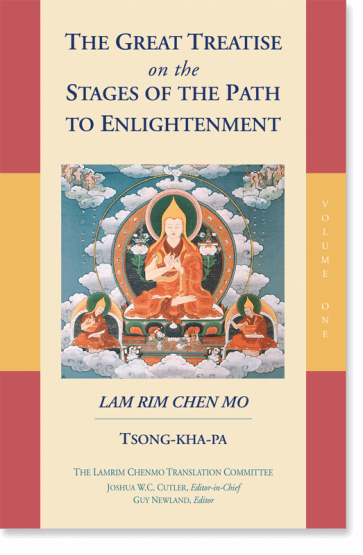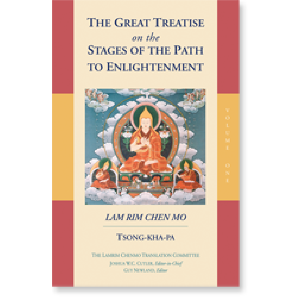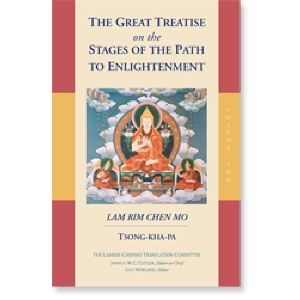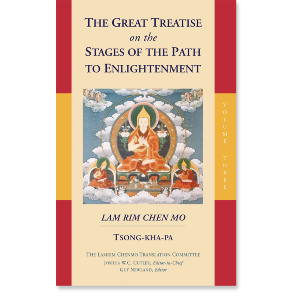| The following article is from the Autumn, 2000 issue of the Snow Lion Newsletter and is for historical reference only. You can see this in context of the original newsletter here. |
he Lamrim Chenmo: Volume One

...one of the greatest religious or secular works in the library of our human heritage.PROF. ROBERT A.F. THURMAN
The Great Treatise on the Stages of the Path to Enlightenment (Lam rim chen mo) is one of the brightest jewels in the world's treasury of sacred literature. The author, Tsong- kha-pa (1357-1419), completed this masterpiece in 1402 and it soon became one of the most renowned works of spiritual practice and philosophy in the world of Tibetan Buddhism. Tsong-kha-pa took great pains to base his incisive insights on the classical Indian Buddhist literature, illustrating his points with classical citations as well as with sayings of the masters of the earlier Kadampa tradition. In this way the text demonstrates clearly how Tibetan Buddhism carefully preserved and developed the Indian Buddhist traditions.
Tsong-kha-pa's text has continued to be essential for any student of Buddhist thought who wants to put the teachings into practice. Because it condenses all the exoteric sutra scriptures into a meditation manual that is easy to understand, scholars and practitioners have for centuries relied on its authoritative presentation as a gateway leading to full understanding of the Buddha's teachings.
The Great Treatise is now being translated in its entirety to be released in three volumes. This first volume establishes that the central focus of the text is the development of the spirit of enlightenment (bod- hicitta'), the heart of the Mahayana tradition. All the practices that are prerequisite for developing the spirit of enlightenment are covered here, making this indispensable reading for anyone who wishes to understand and practice Tibetan Buddhism.
The Great Treatise will be released in three volumes, with volumes 2 & 3 appearing next year.
Of the many works of the Tibetan master Tsong-kha-pa, none compare in terms of popularity and breadth of influence with his Great Treatise on the Stages of the Path to Enlightenment (Lamrim Chenmo), which has been treasured by practitioners and scholars alike for centuries. What distinguishes it as one of the principal texts of Mahayana Buddhism is its scope and clarity. It expoimds the entire path from the way one should rely on a spiritual teacher, which is the very root, right up to the attainment of Buddhahood, which is the final fruit. The various stages of the path are presented so clearly and systematically that they can be easily understood and are inspiring to put into practice.H.H. THE DALAI LAMA
The Great Treatise is one of the world's great monuments of philosophy and spirituality as well as one of the most renowned works of Buddhist thought and practice to have been composed in Tibet. PROFESSOR D.S. RUEGG
Tsong-kha-pa (1357-1419), founder of the Gelug school of Tibetan Buddhism, was one of Tibet's greatest philosophers and a prolific writer. This is the first complete translation into a Western language of The Great Treatise on the Stages of the Path, his most famous work and a classic of Tibetan Buddhism.
The Great Treatise is being translated by The Lamrim Chenmo Translation Committee under the auspices of the Tibetan Buddhist Learning Center, founded in 1958 by the late Geshe Nga- wang Wangyal in Washington, New Jersey. The Lamrim Chenmo Translation Committee is composed of: Jose Cabezon, Daniel Cozort, Joshua W.C. Cutler, Natalie Hauptman, Roger R. Jackson, Karen Lang, Donald Lopez, Jr., John Makransky, Elizabeth S. Napper, Guy Newland, John Newman, Gareth Sparham, B. Alan Wallace, and Joe B. Wilson. The Editor-in-Chief is Joshua W.C. Cutler and the Editor is Guy Newland.
The following is an excerpt from The Great Treatise on the Stages of the Path to Enlightenment.
The defining characteristics of the teacher to be relied upon
Generally, in the scriptures and commentaries many defining characteristics of the teacher are taught from the viewpoint of the individual vehicles. However, the following is a description of a teacher who instructs you in the stages on the paths of the three persons of different capacities and guides you to the Mahayana, which is the path to buddhahood. With respect to this, Maitreya says in his Ornament for the Mahayana Sutras (Mahdyana-sutralamkara):
Rely on a Mahayana teacher who is disciplined, serene, thoroughly pacified;
Has good qualities surpassing those of the students; is energetic; has a wealth of scriptural knowledge;
Possesses loving concern; has thorough knowledge of reality and skill in instructing disciples;
And has abandoned dispiritedness.
Thus Maitreya says that a student must rely on a teacher who has these ten qualities.
It is said that those who have not disciplined themselves have no basis for disciplining others. Therefore, gurus who intend to discipline others' minds must first have disciplined their own. How should they have been disciplined? It is not helpful for them to have done just any practice, and then have the result designated as a good quality of knowledge. They need a way to discipline the mind that accords with the general teachings of the Conqueror. The three precious trainings are definitely such a way. Therefore, Maitreya indicated them with these three terms: disciplined, serene, and thoroughly pacified.
With respect to what Maitreya said, disciplined refers to the training in ethical discipline. The Sutra on the Vows of Individual Liberation (Pratimoksa-sutra) states:
These vows of individual liberation
Are the bridle set with sharp nails.
With constant effort they are fit
For the difficult-to-rein horse of the straying mind.
Also the Exegesis of the Discipline (Vinaya-vibhanga) states:
This is the bridle for undisciplined disciples.
As is implied above, the senses pursue improper objects and, like wild horses, lead you to engage in unsuitable actions. Just as a trainer tames a wild horse with a good bridle, so too teachers learn ethical discipline to control their senses and to turn toward suitable actions with great effort. Hence, teachers have disciplined their minds, which are like wild horses.
Serene refers to having accomplished the training of meditative concentration. Meditative concentration is a mental state in which the mind remains peacefully withdrawn. This is achieved by means of a reliance on mindfulness and vigilance in your ethical discipline, turning away from wrongdoing and engaging in good activities.
Thoroughly pacified refers to having accomplished the training of wisdom. This is done by specifically analyzing the meaning of reality in dependence on meditative serenity, wherein the mind becomes serviceable.
However, to have only the good qualities of knowledge that come from disciplining the mind with the three trainings is not sufficient. Teachers must also have the good qualities of scriptural learning. Therefore, wealth of scriptural knowledge refers to being erudite concerning the three scriptural collections and the like. Geshe Drom- don-ba (dGe-bshes [Brom]-ston-pa) said that when the gurus of the Mahayana give an explanation, they must cause their students to have a deep understanding. When they are putting the teachings into practice, they must demonstrate what is helpful at a time when the teaching is on the wane, and what is useful in the situation at hand.
Knowledge of reality refers to a special training in wisdomthe knowledge of the selflessness of phenomena In another way, it is said to be best if the teachers have a perception of reality; but, if they do not have it, it is acceptable for them to know reality through scripture and reasoning.
Although teachers are endowed with these good qualities of scriptural learning and knowledge, it is not enough for them to have good qualities that are equal to or lower than those of their students; instead, they need qualities that surpass those of their students. The Verses about Friends (Mitra-varga) says:
People degenerate by relying on those inferior to themselves;
By relying on equals, they stay the same;
By relying on those superior, they attain excellence;
Thus rely on those who are superior to yourself.
If you rely on whomever is superiorthoroughly pacified
And endowed with ethical discipline
And exceeding wisdom
You will become superior even to those who are superior.
Pu-chung-wa (Phu-chung-ba) said, When I hear the stories of excellent persons, I emulate them. Ta-shi (mTha'-bzhi) said, I imitate the elders of the Ra-dreng (Ra-sgreng) monastic community. Thus you must emulate those whose good qualities surpass your own.
These six qualitiesbeing disciplined, serene, and thoroughly pacified, having good qualities that surpass those of the students, the wealth of knowledge from studying many scriptures, and thorough knowledge of realityare the good qualities obtained for oneself. The remaining qualitiesbeing energetic, having skill in instruction, possessing loving concern, and abandoning dispiritednessare the good qualities for looking after others.
Further, it says:
Sages do not wash away sins with water,
They do not clear away beings' suffering with their hands,
They do not transfer their own knowledge to others;
They liberate by teaching the truth of reality.
Thus, buddhas perform no actionsuch as washing away others' sins with waterother than looking after others by accurately showing them the path.
Among the four qualities of looking after others, skill in instructing disciples refers to being both skilled in the process of leading disciples and adept at causing them to understand. Possessing loving concern refers to having a pure motivation for giving the teachings. That is, the teacher teaches with a motivation of love and compassion and does not look for gain, respect, and so on. Bo-do-wa said to Jen-nga-wa (sPyan- snga-ba), Son of Li-mo, however many teachings I have explained, I have never taken pleasure in even a single thanks. All beings are helpless. A teacher should be like this.
Energetic refers to constant delight in others' welfare. Has abandoned dispiritedness refers to never being tired of giving an explanation again and againto bearing the hardships of explaining. Bo-do-wa said:
These five qualitiesloving concern, knowledge of reality, and the three trainingsare foremost. My master Shang-tsiin (Zhang-btsun) is not very learned with regard to all the scriptures and cannot withstand dispiriting circumstances. Therefore, he does not even thank those who help him. However, since he has these five qualities, he is helpful to whomever is in his presence. Nyen-don (gNyan-ston) does not have any skill in speech at all. Even when giving a single dedication of an offering, he can only think, None of these people here understands what I am saying. But, as he has the five qualities, he is helpful to whomever enters his presence.
This being the case, those who achieve their own livelihood by praising or explaining the good qualities of the trainings, while not striving diligently to practice them, are not suitable to be teachers. That sort of meaningless praise is only words. It is similar to when someone who diligently seeks sandalwood asks one who makes a living by explaining the good qualities of sandalwood, Do you have any sandalwood? and that person replies, No.
As the King of Concentrations Sutra states:
In later times there will be
Many monks without vows.
Wanting to say, I am learned,
They will praise ethical discipline,
But will not strive diligently at their own ethical discipline.
Having also said this concerning concentration, wisdom, and liberation, the King of Concentrations Sutra states:
Some people express
The good qualities of sandalwood
Saying, Sandalwood is like this:
It is the pleasant aspect of incense.
Then some other people
Might ask them, Do you possess
A bit of that sandalwood
Which you so praise?
They then reply, I do not have
The incense that I praise
To gain my livelihood.
Just so, in later times there will arise
Monks who do not strive at yoga
And make a living by praising ethical discipline.
They will have no ethical discipline.
The sutra states the same for the remaining three qualitiesconcentration, wisdom, and liberation.
The guru who helps you to achieve liberation is the foundation of your deepest aspiration. Therefore, you who wish to rely on a guru should understand these defining characteristics and strive to seek one who has them. Also, those who wish to have students should understand these characteristics and strive to possess them.
Question: Because this is a degenerate time, it is difficult to find a teacher who has these good qualities in their entirety. Therefore, what should we do if we do not find such a teacher?
Reply: The Tantra Requested by Subahu (Subahu-pariprccha-tantra) states:110
Just as a chariot with one wheel
Will not go down the path even though it has a horse,
So too, without assistants for meditation,
People will not gain attainments.
These assistants should have intelligence, a good appearance, great purity,
Be of reputable lineage, and inclined toward the teachings.
They should have great confidence, perseverance, and have disciplined the senses.
They should speak pleasantly, be generous and compassionate,
Forbear hunger, thirst, and the afflictions,
And not worship other deities and brahmins.
They should be focused, adept, grateful,
And have faith in the three jewels.
Since those who have all such good qualities
Are very rare in this age of strife,
Mantra practitioners should rely on an assistant who has
One half, one quarter, or an eighth of these qualities.
Thus it says that assistants should have these defining characteristics in their entirety, or at least one eighth of these. It is explained in Dol-wa's arrangement of Bo-do-wa's Method of Eocplaining that the great Elder [Atisha] said, It is also the same with respect to the guru. Therefore, accept as the defining characteristics of a guru a minimum of one eighth of all the defining characteristics set forth here, combining those that are easy to acquire with those that are difficult to acquire. ä_æ




